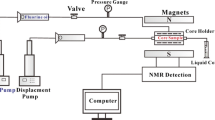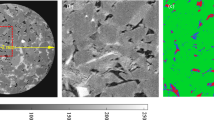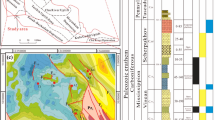Abstract
The heterogeneity of carbonate reservoirs, influenced by sedimentary environments and diagenetic processes, leads to the development of microfractures and vugs, posing significant challenges for reservoir evaluation. This study investigates the complex pore structures of Y-type carbonate reservoirs in the Middle East. We assess the performance of classical permeability prediction models and introduce a novel approach that incorporates a bimodal pore size distribution (PSD) derived from High-Pressure Mercury Injection (HPMI) measurements, accounting for gas slip flow effects. Our results, based on CT imaging, categorize carbonate rock core samples into matrix, fracture, and vuggy. Matrix-type carbonate rocks show a strong correlation between permeability and pore-throat radius, while fracture-type carbonate rock cores exhibit weaker correlations. Traditional model permeability predictions without core categorization yield suboptimal results, with the Winland model achieving the highest R2 of only 0.365. However, after categorization, classical model permeability predictions significantly improve in accuracy. Notably, the introduced bimodal Gaussian PSD model outperforms traditional permeability prediction models, with an R2 of 0.8138, providing a valuable tool for predicting the permeability of carbonate rocks characterized by complex pore structures.












Similar content being viewed by others
Data availability
The data that support the findings of this study are available from the corresponding author upon reasonable request.
References
Archie GE (1942) The electrical resistivity log as an aid in determining some reservoir characteristics. SPE Reprint Series 21:310–314
Barach BAB, Jaafar MZ, Gaafar GR, Agi A, Junin R (2021) Development and identification of petrophysical rock types for effective reservoir characterization: case study of the kristine field, Offshore Sabah. Nat Resour Res 30:2497–2511
Benavides F, Leiderman R, Souza A, Carneiro G, de Vasconcellos Azeredo RB (2020) Pore size distribution from NMR and image based methods: a comparative study. J Petrol Sci Eng 184:106321
Cheng Y, Zhang C, Chen Y (2017) Permeability prediction model of carbonate reservoir based on mercury injection data: a case study of oil-bearing limestone reservoir in KT-Iand KT-IImembers of Zahnanor oilfield. Petrol Geol Recov Effic 24(03):10–17
Dou Q, Sun Y, Sullivan C (2011) Rock-physics-based carbonate pore type characterization and reservoir permeability heterogeneity evaluation, Upper San Andres reservoir, Permian Basin, west Texas. J Appl Geophys 74(1):8–18
Fan X et al (2019) Pore structure evaluation of tight reservoirs in the mixed siliciclastic-carbonate sediments using fractal analysis of NMR experiments and logs. Mar Pet Geol 109:484–493
Fujikura Y (2019) Estimation of permeability for sand and gravel based on pore-size distribution model. J Mater Civ Eng 31(12):04019289
Gao S, Hu Z, Liu H, Ye L (2016) Microscopic pore characteristics of different lithological reservoirs. Acta Petrolei Sinica 37(2):248–256
Ge X et al (2014) Reservoir pore structure classification technology of carbonate rock based on NMR T 2 spectrum decomposition. Appl Magn Reson 45(2):155–167
Godinho JRA, Hassanzadeh A, Heinig T (2023) 3D quantitative mineral characterization of particles using X-ray computed tomography[J]. Natl Resour Res 32(2):479–499. https://doi.org/10.1007/s11053-023-10169-5
Jin X et al (2017) Rock-physics-model-based pore type characterization and its implication for porosity and permeability qualification in a deeply-buried carbonate reservoir, Changxing formation, Lower Permian, Sichuan Bain, China. J Petrol Sci Eng 153:223–233
Klinkenberg LJ (1941) The permeability of porous media to liquids and gases. American Petroleum Institute Drilling and Production-Practice
Kolodzie S (1980) Analysis of pore throat size and use of the Waxman-Smits equation to determine OOIP in Spindle field, Colorado. In: 55th Society of Petroleum Engineers Annual Technical Conference, SPE Paper, 9382(4). https://doi.org/10.2118/9382-MS
Labani MM, Rezaee R, Saeedi A, Hinai AA (2013) Evaluation of pore size spectrum of gas shale reservoirs using low pressure nitrogen adsorption, gas expansion and mercury porosimetry: a case study from the Perth and Canning Basins, Western Australia. J Petrol Sci Eng 112:7–16
Li B et al (2017) Fracture and vug characterization and carbonate rock type automatic classification using X-ray CT images. J Petrol Sci Eng 153:88–96
Lin B, Chen M, Jin Y, Pang H (2015) Modeling pore size distribution of southern Sichuan shale gas reservoirs. J Natl Gas Sci Eng 26:883–894
Lin B, Chen Y, Chen M, Jin Y, Jiang Z (2018) Application of multi-peak pore size distribution model in pore structure analysis of shale. Nat Gas Geosci 29(03):397–403
Liu K, Ostadhassan M, Jie Z, Gentizs T, Rezaee R (2017) Nanoscale pore structure characterization of the Bakken shale in the USA. Fuel 209:567–578
Meng Y, Li Z, Lai F (2021) Influence of effective stress on gas slippage effect of different rank coals. Fuel 285:119207
Nimmo JR (2004) Porosity and pore size distribution. Encycl Soils Environ 3(1):295–303
Nooruddin HA, Hossain ME, Al-Yousef H, Okasha T (2014) Comparison of permeability models using mercury injection capillary pressure data on carbonate rock samples. J Petrol Sci Eng 121:9–22
Norbisrath JH, Weger RJ, Eberli GP (2017) Complex resistivity spectra and pore geometry for predictions of reservoir properties in carbonate rocks. J Petrol Sci Eng 151:455–467
Peng A, Jiang M (1986) Calculation of tourtuosity by means of capillarity data. Pet Explor Dev (in Chinese) (1):59–63. https://.CNKI:SUN:SKYK.0.1986-01-008
Pittman ED (1992) Relationship of porosity and permeability to various parameters derived from mercury injection-capillary pressure curves for sandstone. AAPG Bull 76(2):191–198
Regnet JB, David C, Robion P, Menéndez B (2019) Microstructures and physical properties in carbonate rocks: a comprehensive review. Mar Pet Geol 103:366–376
Saner S, Al-Harthi A, Htay MT (1996) Use of tortuosity for discriminating electro-facies to interpret the electrical parameters of carbonate reservoir rocks. J Petrol Sci Eng 16(4):237–249
Shi K et al (2023) Pore structure characteristics and evaluation of carbonate reservoir: a case study of the lower carboniferous in the marsel exploration area, Chu-Sarysu basin. Natl Resour Res 32(2):771–793
Swanson BF (1981) A simple correlation between permeabilities and mercury capillary pressures. J Petrol Technol 33(12):2498–2504
Tian H, Wang G, Feng Q (2020) Review and prospective of complex pore structure of carbonate reservoir. Sci Technol Eng 20(29):11825–11833
Tian W et al (2022) A relative permeability model considering nanoconfinement and dynamic contact angle effects for tight reservoirs. Energy 258:124846
Wang F, Yang K (2021) Influence of pore throat size distribution on oil displacement by spontaneous imbibition in tight oil reservoirs. Lithol Reser 33(2):155–162
Wang F, Zeng F (2020) Novel insights into the movable fluid distribution in tight sandstones using nuclear magnetic resonance and rate-controlled porosimetry. Nat Resour Res 29(5):3351–3361
Wang F, Li Y, Tang X, Chen J, Gao W (2016) Petrophysical properties analysis of a carbonate reservoir with natural fractures and vugs using X-ray computed tomography. J Natl Gas Sci Eng 28:215–225
Wang F, Jiao L, Lian P, Zeng J (2019) Apparent gas permeability, intrinsic permeability and liquid permeability of fractal porous media: carbonate rock study with experiments and mathematical modeling. J Petrol Sci Eng 173:1304–1315
Wardlaw NC, Taylor RP (1976) Mercury capillary pressure curves and the interpretation of pore structure and capillary behavior in reservoir rocks. Bull Can Pet Geol 24(2):225–262
Xu C, Torres-Verdín C (2013) Pore system characterization and petrophysical rock classification using a bimodal Gaussian density function. Math Geosci 45(6):753–771
Yoo H, Park J, Lee Y, Lee J (2019) An experimental investigation into the effect of pore size distribution on the acid-rock reaction in carbonate acidizing. J Petrol Sci Eng 180:504–517
Acknowledgements
This work was supported by the Sinopec Research Project “Key Technologies for Greatly Improving Oil Recovery in Multilayer High Water Cut Reservoirs”, under Grant No. P22021.
Funding
Sinopec Research Project, P22021.
Author information
Authors and Affiliations
Contributions
H.Y. analyzed the data and wrote the original paper; H.L., H.H., and J. H. revised the manuscript; revised the manuscript; F.W. proposed the idea and the method of the paper and revised the manuscript. All authors reviewed the manuscript.
Corresponding author
Ethics declarations
Conflict of interest
The authors declare that they do not any actual or potential conflict of interest.
Additional information
Publisher's Note
Springer Nature remains neutral with regard to jurisdictional claims in published maps and institutional affiliations.
Appendices
Appendix A
The pore size distribution of all cores has been fitted by Gaussian. Table 7 shows the fitting parameters and fitting reliability of 33 cores, respectively.
Appendix B
The prediction results of the Gaussian bimodal model were revised by considering the gas slippage effect. Table 8 shows the model calculation and calibration results of the Gaussian bimodal model for 33 cores.
Rights and permissions
Springer Nature or its licensor (e.g. a society or other partner) holds exclusive rights to this article under a publishing agreement with the author(s) or other rightsholder(s); author self-archiving of the accepted manuscript version of this article is solely governed by the terms of such publishing agreement and applicable law.
About this article
Cite this article
Yue, H., Liu, H., Hua, H. et al. Comprehensive pore structure characterization and permeability prediction of carbonate reservoirs using high-pressure mercury intrusion and X-ray CT. Carbonates Evaporites 39, 18 (2024). https://doi.org/10.1007/s13146-024-00923-y
Accepted:
Published:
DOI: https://doi.org/10.1007/s13146-024-00923-y




